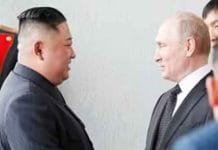The North Korea announced on October 23, 2025 that it had successfully tested a “cutting-edge” weapons system involving hypersonic projectiles. The test comes just a week ahead of the upcoming Asia-Pacific Economic Cooperation (APEC) summit, scheduled to involve many regional leaders. Reuters+1
🔹 What happened?
According to state media Korean Central News Agency (KCNA), the missiles were launched from a region south of Pyongyang and hit a target in the country’s northeastern interior. While the exact range, speed or trajectory were not disclosed, the fact that the test used hypersonic manoeuvring projectiles — weapons that travel at more than five times the speed of sound and are difficult to intercept — signals a higher-tier threat. www.ndtv.com
South Korea’s military confirmed detection of what appeared to be short-range ballistic missile launches the same day, adding to the gravity of the announcement. Nippon+1
🔹 Why the timing matters
The test’s timing is provocatively placed just days before the APEC summit, which will see the U.S. President and other regional dignitaries gather in South Korea. Many analysts view the launch as a signal from Pyongyang to assert its strategic deterrence and test the readiness of allied responses in a high-visibility window. Bloomberg
🔹 Regional security implications
South Korea and the U.S. announced strong condemnation. U.S. Forces Korea labelled the launches “unlawful and destabilising”. Reuters
For Japan and other nearby states, the possibility of hypersonic missile threats not just to regional but offshore assets raises defense-planning alarms.
The international sanctions regime against North Korea may face renewed pressure — both politically and diplomatically.
🔹 Strategic context for North Korea
Pyongyang has in recent years advanced its missile programme and deepened ties with Russia and Iran. Hypersonic technology in particular is viewed by North Korean leadership as a force-equaliser, helping counter the missile-defence systems of the U.S. and allies. Nippon
Pak Jong Chon, a senior official cited by KCNA, said the weapon system test demonstrates “steadily upgrading self-defensive technical capabilities of the DPRK” (Democratic People’s Republic of Korea). www.ndtv.com
🔹 What’s at stake for global diplomacy
The APEC summit may now enter with a heightened security overlay — regional leaders will likely address North Korea’s actions in sideline meetings.
U.S.–China diplomacy, already fragile, may be complicated by this launch. If North Korea is seen as acting with China’s tacit support or silence, tensions could escalate.
Arms-control and non-proliferation regimes will once again confront the challenge of hypersonic weapons, which blur the line between conventional and nuclear deterrence.
🔹 What to watch next
Will South Korea or the U.S. conduct joint military exercises or missile-defence drills in response?
Will there be any response from the U.N. Security Council or new sanctions announced?
How will China and Russia publicly position themselves during or after the APEC summit regarding this launch?
How will markets and regional defence-contracting firms respond (e.g., surge in defence-stock prices, regional procurement announcements)?
“The new weapon system is a clear proof of steadily upgrading self-defensive technical capabilities of the DPRK,” declared Pak Jong Chon via KCNA. www.ndtv.com
For India, and South Asia more broadly, while this is a geographically distant development, the implications ripple outward: missile-technology proliferation, regional alliance dynamics and shifting strategic dependencies all matter for defence-procurement and diplomatic posture.
In summary: North Korea’s hypersonic test is more than a news item — it is a wake-up call to the changing face of missile technology, deterrence and diplomacy in the Asia-Pacific in 2025.














